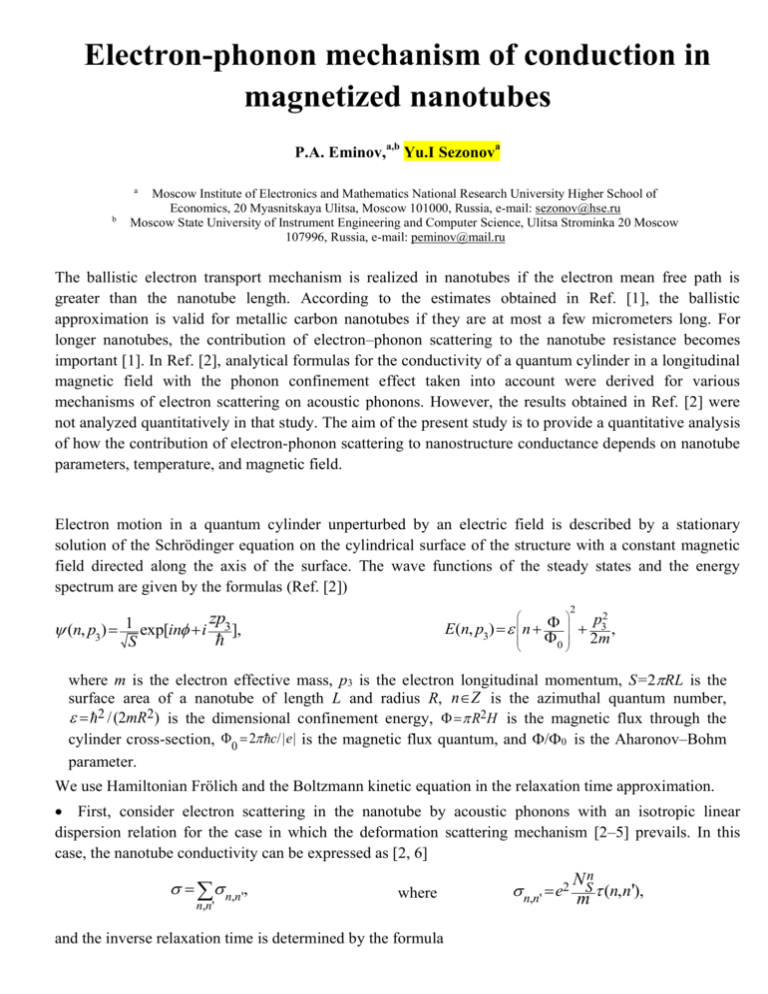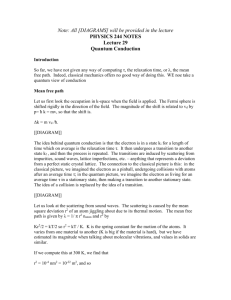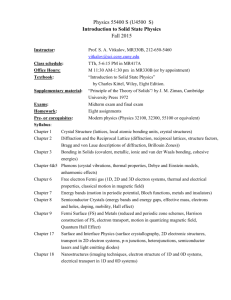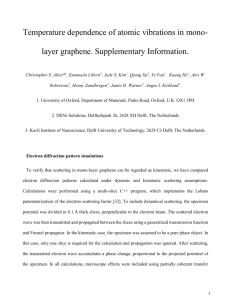Electron-phonon mechanism of conduction in magnetized
advertisement

Electron-phonon mechanism of conduction in magnetized nanotubes P.A. Eminov, a,b Yu.I Sezonov a a b Moscow Institute of Electronics and Mathematics National Research University Higher School of Economics, 20 Myasnitskaya Ulitsa, Moscow 101000, Russia, e-mail: sezonov@hse.ru Moscow State University of Instrument Engineering and Computer Science, Ulitsa Strominka 20 Moscow 107996, Russia, e-mail: peminov@mail.ru The ballistic electron transport mechanism is realized in nanotubes if the electron mean free path is greater than the nanotube length. According to the estimates obtained in Ref. [1], the ballistic approximation is valid for metallic carbon nanotubes if they are at most a few micrometers long. For longer nanotubes, the contribution of electron–phonon scattering to the nanotube resistance becomes important [1]. In Ref. [2], analytical formulas for the conductivity of a quantum cylinder in a longitudinal magnetic field with the phonon confinement effect taken into account were derived for various mechanisms of electron scattering on acoustic phonons. However, the results obtained in Ref. [2] were not analyzed quantitatively in that study. The aim of the present study is to provide a quantitative analysis of how the contribution of electron-phonon scattering to nanostructure conductance depends on nanotube parameters, temperature, and magnetic field. Electron motion in a quantum cylinder unperturbed by an electric field is described by a stationary solution of the Schrödinger equation on the cylindrical surface of the structure with a constant magnetic field directed along the axis of the surface. The wave functions of the steady states and the energy spectrum are given by the formulas (Ref. [2]) (n, p3) 1 exp[in i zp3 S E (n, p3) n 0 ], 2 p32 , 2m where m is the electron effective mass, p3 is the electron longitudinal momentum, S=2RL is the surface area of a nanotube of length L and radius R, nZ is the azimuthal quantum number, 2 / (2mR2) is the dimensional confinement energy, R2H is the magnetic flux through the cylinder cross-section, 0 2 c/| e | is the magnetic flux quantum, and 0 is the Aharonov–Bohm parameter. We use Hamiltonian Frölich and the Boltzmann kinetic equation in the relaxation time approximation. First, consider electron scattering in the nanotube by acoustic phonons with an isotropic linear dispersion relation for the case in which the deformation scattering mechanism [2–5] prevails. In this case, the nanotube conductivity can be expressed as [2, 6] n,n', where n,n ' and the inverse relaxation time is determined by the formula n N n,n' e2 mS (n, n '), BDm 1 1 2 q J nn'(q R) 1 pF (n ') 0 q2 ( pF pF ')2 pF (n ') 1 pF (n) exp v q2 ( p p ')2 1 F F T 2 2 q ( pF pF ') pF (n ') dq . pF (n) exp v q2 ( p p ')2 1 F F T The dependence of the nanotube conductivity on the Aharonov–Bohm parameter and temperature is shown in Figs. 1a and 1b, respectively. Next, consider electron scattering by longitudinal and flexural acoustic phonons. If only the longitudinal acoustic mode contributes to the scattering rate, then the conductivity of the quantum cylinder can be expressed as [2] n . where n ( pF 2 e n N Sn ( pF (n)) ( pF (n)) , 2m exp 2v | T (n)) pF (n) mv | 1 exp 2v | T mv 8mA2 1 p ( n ) F pF (n) mv | 1 The nanotube conductivity as a function of the Aharonov–Bohm parameter and temperature is shown in Fig. 2a and 2b, respectively. In the limiting case in which | q3 | R 1, the interaction of electrons with the flexural wave prevails, and the phonon absorption and emission processes are accompanied by a change of 1 in the electronic azimuthal quantum number; i.e., n' n 1, respectively. In this case, we obtain the following result for the nanotube conductivity [2]: 2 n e n m N S (n), n, n where Fn,n1 2m 1 [ pF (n) pF (n 1) pF (n) pF (n 1) 1 pF (n) pF (n 1) 1(n) Fn,n1 Fn,n1, 1 2 sinh vR [ pF (n) pF (n 1)] T 2 A ] . 3 (23) 2R vR sinh [ pF (n) pF (n 1)]2 T 1 For flexural waves, the oscillating dependence of the nanotube conductivity on the Aharonov–Bohm parameter is shown in Fig. 3a, and the temperature dependence of the tube resistance is shown in Fig. 3b. We have carried out a quantitative study of the contribution of electron scattering by longitudinal and flexural phonons to the resistance of a quantum cylinder in a longitudinal magnetic field. The dependence of the nanostructure conductance on the nanotube radius, the surface electron density, temperature, and the Aharonov–Bohm parameter for the case of an isotropic phonon spectrum and the case in which phonon confinement effects are taken into account have been studied. It has been shown that the change in the Aharonov–Bohm parameter is accompanied by an oscillating change in nanotube conductivity. The oscillation amplitude increases dramatically if phonon dimension confinement effects are taken into account as well as if there are processes leading to a change in the transverse motion energy of the electrons as a result of their interaction with the phonons. Figure 1. Isotropic phonon spectrum Figure 2. Longitudinal phonons Figure 3. Flexural phonons (a) Nanotube conductivity versus the Aharonov–Bohm parameter; 0 is the nanotube conductivity in the magneticfield-free case, the temperature T is 10 К, and the levels n=0, n=1, n= - 1, and n= - 2 are occupied. (b) Nanotube resistance against temperature in the magnetic-field-free case; 0 is the nanotube linear resistance at temperature T=10 К. The nanotube has radius R=5 nm. The linear concentration is NL=0.25 109 m-1 (1) and NL=0.3 109 m-1 (2). References [1] H. Suzuura and T. Ando, Phonons and electron-phonon scattering in carbon nanotubes, Phys. Rev. B 65 (2002) 235412-235426. [2] P. A. Eminov, A. A. Ul’din, Yu. I. Sezonov, Electron-phonon scattering and conductivity of a quantum cylinder in a magnetic field, Physics of the Solid State. 53 (2011) 1707-1713. [3] L. I. Magarill, M. V. Entin, Inductive current in a quantum ring, Journal of Experimental and Theoretical Physics Letters. 80 (2004) 421–425. [4] M.А Stroscio, M. Dutta, Phonons in nanostructures, Cambridge University Press, Cambridge, 2001. [5] I.A.Kvasnikov, Theory of nonequilibrium systems, Editorial URSS, Moscow, 2003. (in Russian) [6] P. A. Eminov, A. A. Ul’din, Yu. I. Sezonov, S. V. Gordeeva, Electron-phonon interaction and electrical conductivity of a nanotube in an external magnetic field, Russian Physics Journal. 54 (2011) 54-56.


![Description This tool runs the model described in Ref. [1] below. It](http://s3.studylib.net/store/data/007555824_1-2f0124cd3aa95426766ad7b8bcd713b0-300x300.png)






